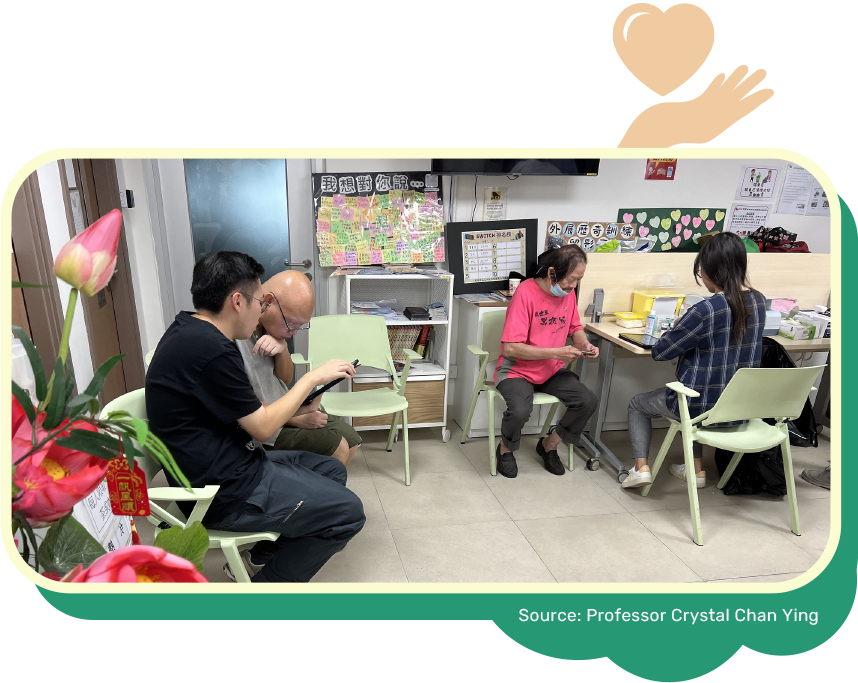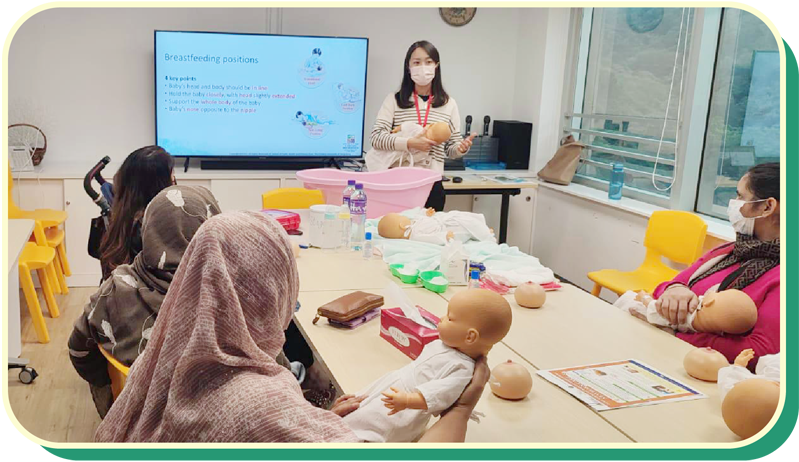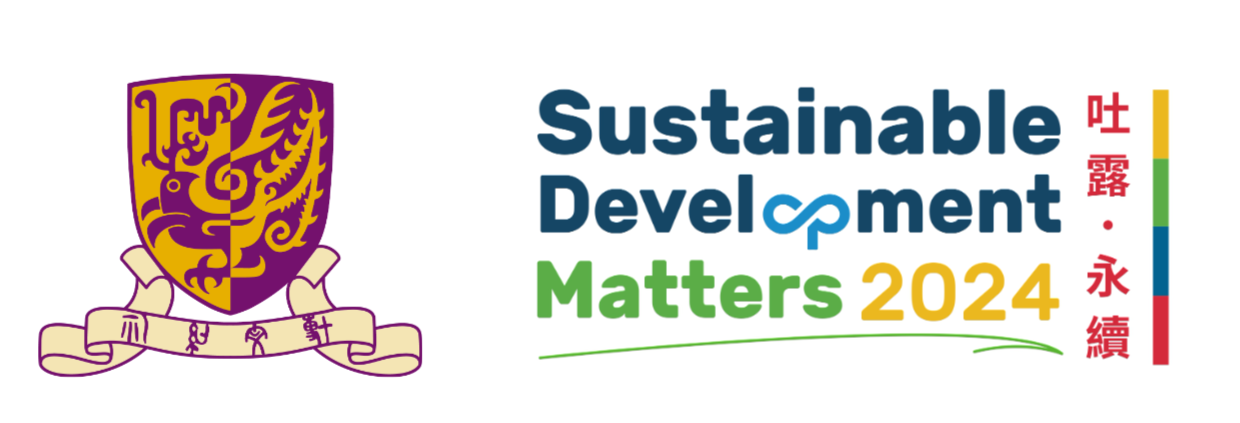From office to community
CUHK staff volunteers empowering disadvantaged communities through multiple initiatives funded by the Sustainable Development Goals Action Fund

For many people, ‘volunteering’ may feel like just another form of community service: something uplifting and vaguely worthwhile that we do during our spare time. But for Professor Dong Dong, Professor Crystal Chan, and Mr Henry Sin, three academics and social workers from CUHK’s Jockey Club School of Public Health, it forms a vital component of their work. ‘Finding volunteers isn’t very difficult for us, especially when public health is involved — a lot of people just want to help’, says Professor Dong.
Nevertheless, it is one thing to find volunteers, and another to develop a project that makes the best use of their help. ‘I’ve been doing these projects for quite a while now, and I can’t help but ask myself whether this is really what this community needs’, continues the professor. Given the time, money and personnel that a project requires, there is pressure to create projects that will be, in Mr Sin’s words, both ‘sensitive and practically applicable’ to disadvantaged members of society, as well as constituting valuable and meaningful experiences for those who participate.
‘For a worker who’s earning around a few thousand dollars a month, asking them to fork out a fifth of their salary just for a bit of medical advice can be very difficult’, says Mr Sin. Working with labour unions for the migrant workers, Mr Sin and his team have conducted screenings in community centres, using electrocardiograms and checking vital signs such as blood pressure and respiratory rates.

A screening event for cardiovascular disease held by Mr Sin’s team
Professor Dong’s project also helps the South Asian community, enabling women to prepare to become a mother. These women often hail from countries where there is little education about baby care. ‘When you have a child, you need so much support, and these women simply don’t get it’, she says. Communication is also a problem: most of these mothers have only limited English or Chinese, and are not used to operating in a Chinese culture. This often scares them away from seeking medical help. With that in mind, Professor Dong and her team set about providing alternative methods of educating South Asian women on perinatal and newborn health, including a series of videos hosted on YouTube that teach these new mothers newborn care knowledge, such as preventing burns and scalds during baths, and methods of changing diapers. They have also conducted talks and explored the possibility of training South Asian women as maternal caregivers, allowing them to expand their community and employment prospects.
Although Professor Chan’s outreach is mainly directed towards the homeless, she has a similar goal in helping them regain agency. ‘The decision to focus on wound care came after extensive needs assessment and consultation with the homeless community and local organisations’, she says. ‘Initially, we explored a broader range of health interventions, including vaccination drives, mental health support, and hygiene education. In the end, however, wound care emerged as one of the most important unmet needs’.
The team has also taken great pains to develop a wound-care kit suitable for use by street sleepers. The kit is compact, lightweight, discreet, hypoallergenic and durable, and is also suitable for use in unsanitary conditions. ‘We sought feedback from recipients to refine the kits over time, and their input helped us make adjustments’, says Professor Chan.
All three interviewees collaborate frequently with CUHK staff and students on their volunteering projects. They draw on the expertise of people coming from disciplines such as nursing, social work and public health because, as Professor Chan states, ‘their expertise and commitment are invaluable’.

Professor Chan provides her volunteers with orientation sessions to destigmatise homelessness, while Mr Sin provides his with cultural mentorship. ‘Although the initial training requires a significant investment in time and resources’, says the latter, ‘the structured approach ensures that most volunteers reach a level of competency’ that ensures the continuation of their efforts.
Mr Sin’s project has assisted more than fifty migrant workers in different districts, Professor Dong’s videos have been viewed more than 2,600 times, and Professor Chan’s team has helped over 30 street sleepers in two different districts. Despite this success, however, the interviewees emphasise that their work is only just beginning. ‘We’ve been working with the South Asian community for years now’, says Professor Dong, ‘and we’ve come to recognise that there’s a great demand for services to different communities, because they don’t get that many resources’. There is still scope for expansion, for more volunteers, in these projects.
Learning about the differences between Hong Kong and South Asian cultures formed a major part of their experience. ‘We might have experience of working with them in public hospitals’, says Liza, ‘but there’s still so much we don’t know about their cultural practices’. Although they had prepared a lot of material to educate their audiences on maternal caregiving, they soon came to realise that they needed a more targeted approach to fit into the new mothers’ situations, instead of applying their own knowledge wholesale.

A talk on newborn care organised by Professor Dong’s team
As a result, the volunteers adjusted their approach more than once during the project. They had planned a series of lectures for South Asian women on maternal caregiving, but the COVID-19 pandemic meant that they had to convert their knowledge into a series of YouTube videos as well as Zoom consultations. Likewise, the dietary knowledge they had hoped to impart conflicted in some respects with their audience’s cultural and religious beliefs, meaning Professor Dong’s team had to look for suitable alternatives. ‘We hope to talk more with South Asian women, so that we can add elements to the project that can really help them’, says Liza.
While they remain enthusiastic about developing volunteering projects, all three leaders admit that time is a huge obstacle when it comes to putting boots on the ground. ‘Here in Hong Kong, people are always busy. They can barely spare the time to come and take care of marginalised communities. There’s also the problem that sometimes the people you’re trying to help just don’t show up’, says Professor Dong. For the teams, a meaningful volunteering experience can be just as important as results in the field, which is why the helpers are given a flexible schedule to participate in the work.
Compensating these volunteers for their time, as well as educating them on the value of their work, is therefore very important. Professor Chan notes how CUHK staff members can gain time-release of up to 15 work hours each academic year for community service activities starting from 1 November 2024. ‘This certainly helps employees become more comfortable with donating their time, and they definitely feel it’s more worthwhile’.
Chamois Chui is an editor in the Communications and Public Relations Office, The Chinese University of Hong Kong.

